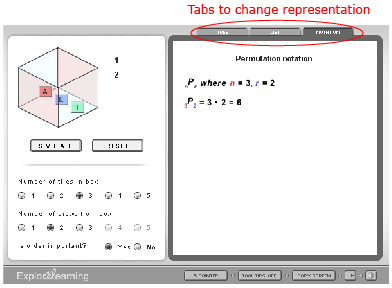Explore
In Try This 1 you looked at permutations and combinations of ice cream cones. The number of combinations is the number of ways you can select items from a group when order does not matter. In Two Scoops, a chocolate-strawberry cone is the same as a strawberry-chocolate cone.
You may have noticed in Try This 1 that the notation for combinations is similar to that of permutations.
| Notation | Order | Ice Cream Cone Possibilities | |
| Combination | nCr | Order doesn’t matter. | 4C2 = 6 |
| Permutation | nPr | Order matters. | 4P2 = 12 |
In Try This 1, nCr represents taking r objects (two flavours) from a group of n objects (four possible flavours), when order does not matter. In nPr, the restriction on r is r ≤ n.
This restriction on r is also true for nCr because you can’t choose more objects than are available.
In Try This 2 you will explore combinations and compare them to permutations.
Try This 2
Step 1: Open “Permutations and Combinations.”
In “Permutations and Combinations” you see the number of ways you can take items from a box. You are also allowed to decide whether or not to pay attention to the order in which you take the items from the box.
Step 2: Set “Number of tiles in box” to 3. Set “Number of draws from box” to 2, and then select “Yes” to indicate the order is important, as shown in the diagram. This setting corresponds to the first line of the following table. Hit “Simulate.” Switch between the tabs at the top for different representations of the information.

Screenshot reprinted with permission of ExploreLearning
Complete a table like the one shown by changing the tiles, draws, and order of importance.
| Tiles | Draws | Is order important? | Number of Possibilities | Sketch of Tree Diagram | Notation | Permutation or Combination |
| 3 | 2 | yes | 6 | 3P2 | permutation | |
| 3 | 2 | no | ||||
| 5 | 2 | yes | Do not draw. | |||
| 5 | 2 | no | Do not draw. | |||
| 4 | 3 | no | Do not draw. | |||
| 4 | 4 | no | Do not draw. | |||
| 5 | 5 | no | Do not draw. |
![]() Save your responses in your course folder.
Save your responses in your course folder.
Share 2
With a partner or group, discuss the following questions based on what you discovered in Try This 2.
-
How did the tree diagram change when you switched from order being important to being not important?
- Why are there fewer combinations of a specified number of items as compared to the number of permutations?
- “Permutations and Combinations” shows that the permutation and combination formulas are related by
 Explain why dividing the number of permutations by r! gives the number of combinations.
Explain why dividing the number of permutations by r! gives the number of combinations. - Think of a real-life example where you would be interested in the number of combinations rather than the number of permutations.
